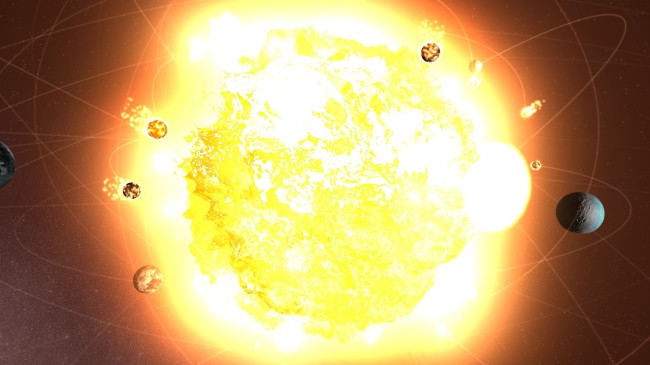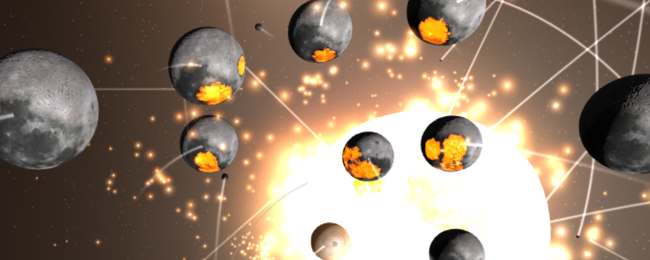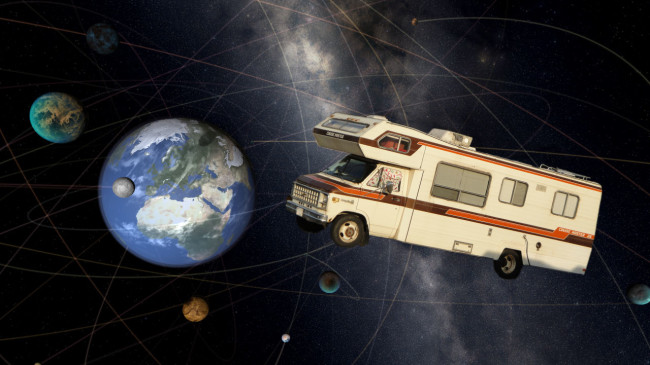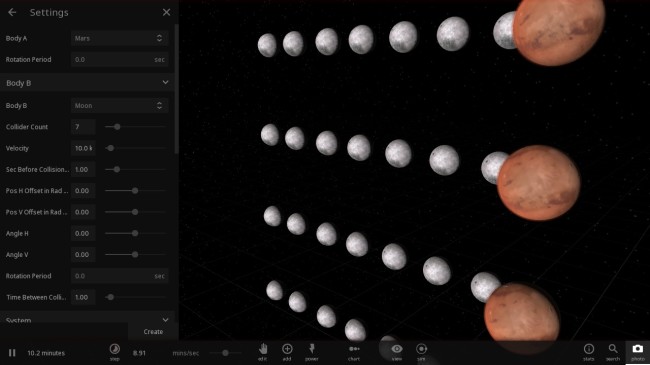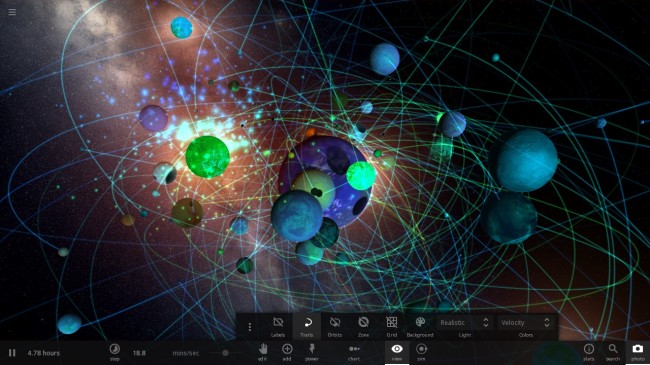Help Us Test the New Alpha 19 Preview
May 31st
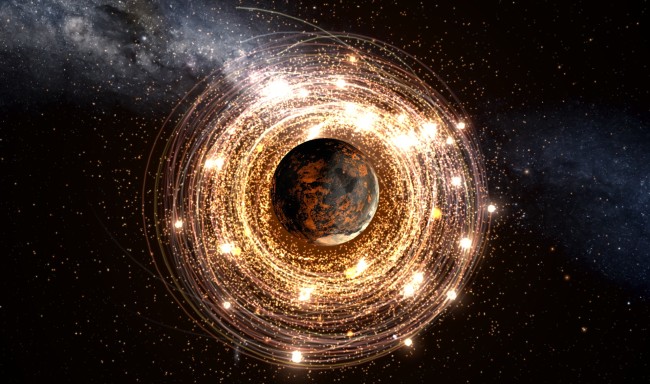
We’re getting very close to officially releasing Alpha 19.
But before we can do that, we need help testing the latest preview version, Alpha 19 x3.
If you’ve already opted in to the preview version, Steam will automatically download this update.
Opt in to the Alpha 19 preview:
- Right-click on the game title in your Steam Library
- Click on ‘Properties’
- Select the ‘Betas’ tab
- Set the dropdown menu to ‘alpha19preview’
- Close the Properties window
- Steam will now update Universe Sandbox ² to the preview version
- Once updated, launch Universe Sandbox ²
Since the last preview version, Alpha 19 x2, we’ve improved the tidal heating and Roche limit effects, made further improvements to explosions, added new Physics sims and a tidal forces tutorial, added a new Milky Way background, and fixed a ton of bugs.
For a full list of what’s new, improved, and fixed since Alpha 18, see our release notes: What’s New.
When testing, please pay the most attention to the new tidal forces and explosion effects. You can share issues with us in-game via Home > Send Feedback, or on our forums: Official Forum | Steam Forum
The team is in Amsterdam this week for the Unite Europe 2016 conference. Once we’re all back we’ll work on fixing any remaining issues and polish up Alpha 19 for release.
Thanks for testing and for your patience!
More Love for Universe Sandbox ² VR
May 27th
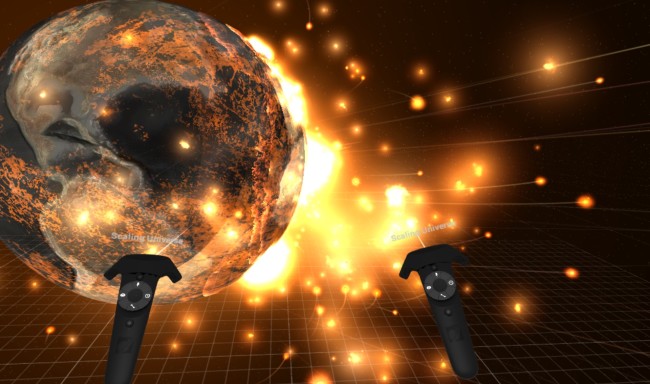
When we began work on the VR mode for Universe Sandbox ² at the end of last year, we weren’t really sure how it would turn out, or what people would think of it.
Now, a few months after our VR launch, the picture is a bit more clear: Universe Sandbox ² in VR is awesome, and people love it.
That may sound like it needs a dose of modesty, but take a look at what people are saying below. Space is a great setting for experiencing the sense of scale that VR allows, and a number of users have talked about the wonder (and sometimes dread) that comes with floating next to a true-to-scale Sun. Quite a few users have even said that Universe Sandbox ² has been their best VR experience. But again, no need to take our word for it.
The first Tweet here is from Dean Hall, the creator of DayZ.
Just tried out @UniverseSandbox 2 on the Vive. Created a sun in front of me. Instantly terrified. So I tried to shoot it with moons. Amazing
— Dean Hall (@rocket2guns) May 16, 2016
played @UniverseSandbox 2 in #VR with the @htcvive. I don't think I have had a more humbling and at the same time amazing experience ever
— Will Healy (@HealyIV) May 4, 2016
Universe Sandbox in HTC Vive is so phenomenally awesome. Best VR experience I've ever had. https://t.co/JJzhbyitRe @UniverseSandbox
— Jon Brouchoud (@ARCHVirtual) May 14, 2016
@UniverseSandbox I just tried Universe Sandbox 2 on the vive & i can only describe it as Amazing. You really created Something special
— Ifod (@Ifodder) May 5, 2016
Ctrl V is a VR arcade opening up in Canada very soon, for those who’d like to try out VR before purchasing their own headsets. Universe Sandbox ² will be one of the titles available in their libraries. The team at Ctrl V recently tried out Universe Sandbox ² for the first time and sent us this wonderful email:
We here at Ctrl V, are speechless… This game is phenomenal on so many levels. The level of detail and customization available exceeded all of our expectations.
Everyone on our team has both tested, loved, and gotten completely lost in the beauty of this game.
We had never anticipated that a non-shooting VR game would steal the spotlight, but your wizardry has managed to do just that.
— Ryan from Ctrl V
Steam Reviews
This is just a selection of Steam reviews which have praised the VR mode in Universe Sandbox ². It’s impossible to capture them all, because they keep rolling in every day.
…this is the most unbelievable experience you will ever have, VR or otherwise. […] You will not come back from this experience the same. You’ve been warned.
This is perfect for VR. […] If you have VR, you know that some things just make you smile and laugh a little because something cool just happened. This happened almost constantly with this game.
Of all the VR games/Experiences I have (which is pretty much all of them) this is at the top of my list. Get it!!!
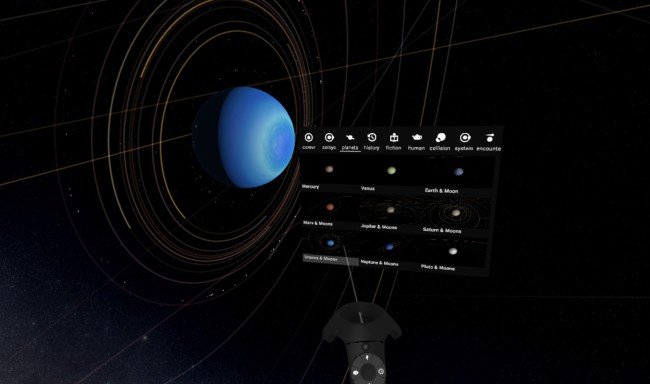
I’m a grown man and I literally shed tears when I stood next to Earth spinning peacefully in the vastness of space and looked back at our life-giving Sun so far away and yet so close.
A breathtaking experience for anyone even slightly interested in space exploration.
VR is a must. Completely changes the experience.
My mind was sufficiently blown the first time I entered Universe Sandbox ² in VR. It remains so every time I reboot.
This on the HTC Vive is the most amazing thing I’ve ever experienced. The absolute scale of the universe and the accurate depiction of our solar system is totally awe-inspiring. Words, videos or pictures don’t do it justice. It has to be experienced to fully understand how awesome this is.
Played in VR on the HTC Vive and the sense of scale was incredible. I played around with a couple of stars the size of my fist, trying to get them into a binary orbit, but I accidentally collided them and then *boom* my entire room filled with a massive explosion that I was just a speck inside. Just incredible.
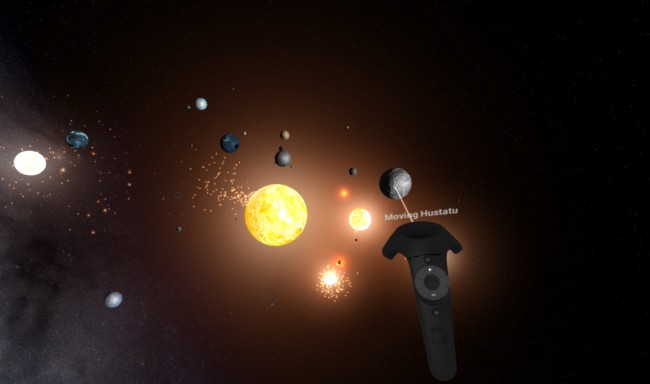
Sooooo great with HTC VIVE… One of the best experiences in virtual reality. I usually play it lying on the floor… Love the Big supernovas once you make two stars explode.
Wow… Incredible with HTC VIVE… A complete fantastic submersion in space dynamics. One of the best experiences in virtual reality!
After more intense and exhausting room-scale sessions wear me down this is what I’ve came back to for end of the night relaxation. I’ll sit in the middle of my VR space and mellow out to the beautiful soundtrack and play with the fabric of creation. Pretty damn cool.
One of the most amazing things I’ve witnessed in VR.
Incredible in VR, must buy if you have a Vive. Great soundtrack. Developers continue to push out amazing updates for virtual reality.
If you don’t have VR, don’t worry, we’re still developing the desktop version of Universe Sandbox ² and expect to release Alpha 19 soon, which will feature some really awesome new Roche limit and tidal heating effects. If you’re itching to try this out, you can opt into a preview version of Alpha 19. Learn more here: Alpha 19 Preview.
New Spacecraft Models Coming in Alpha 19
May 6th
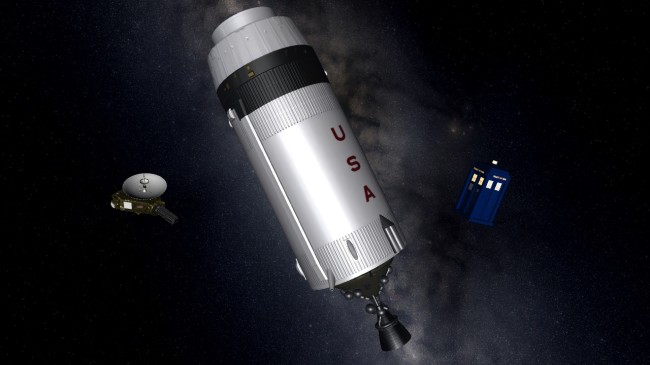
New models in Alpha 19. Left to right: New Horizons, Saturn V 3rd Stage, Police Box
Alpha 19 is not yet officially available. You can try an opt-in preview version of Alpha 19 via Steam:
- Right-click on the game title in your Steam Library
- Click on ‘Properties’
- Select the ‘Betas’ tab
- Set the dropdown menu to ‘alpha19preview‘
- Close the Properties window
- Steam will now update Universe Sandbox ² to the preview version
- Once updated, launch Universe Sandbox ²
In Alpha 19 we’ve added in new models for 3 different kinds of spacecraft: the New Horizons Probe, the Third Stage of the Saturn V rocket, and a police box.
These models were made by Toby Halter for Universe Sandbox ². Older alpha versions of Universe Sandbox ² had models for both the New Horizons Probe and the Saturn V 3rd Stage, but Toby completely remade these, adding a lot more detail and texture to make them much truer to the real spacecraft. And thanks to Georg, our shader wizard, for working his magic on these models and implementing them in Universe Sandbox ².
1. Third Stage of the Saturn V Rocket
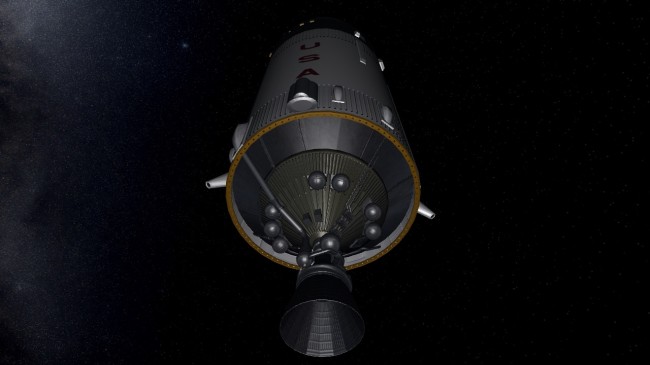
This model is based on the third stage of the Saturn V rocket which was used in the 1969 Apollo 12 mission, the second to land astronauts on the moon.
The simulation in Universe Sandbox ² refers to the discovery of what was suspected to be an asteroid orbiting Earth in 2002. After more observation, however, astronomers concluded the most likely explanation was that this object was not an asteroid, but rather the third stage of the Saturn V rocket used in Apollo 12. It was likely flung out of Earth’s orbit in 2003, but there’s a good chance it’ll show up again in a few decades.
Check it out in the included sim: Home > Open > Third Stage of the Apollo 12 in Orbit of Earth in 2003.
Or you place it in any simulation: Add > Objects tab > Third Stage of the Apollo 12.
2. New Horizons Probe
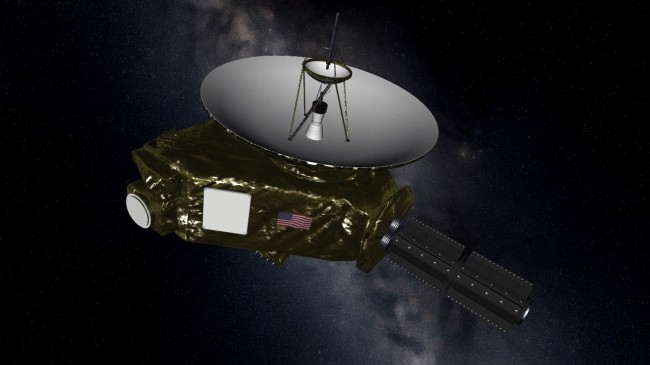
The New Horizons probe is most famous for giving us our first close look at Pluto, which it approached in July, 2015. Now that it’s sent us detailed pictures of Pluto and its moons, it continues on its way toward the very distant Kuiper Belt.
The most notable change between this model and the old one is the shiny, gold foil wrapped around it, which serves as a insulating blanket for the grand piano-sized probe.
Check it out in the included sim: Home > Open > New Horizons Pluto Encounter in 2015.
Or you place it in any simulation: Add > Objects tab > New Horizons.
3. Police Box
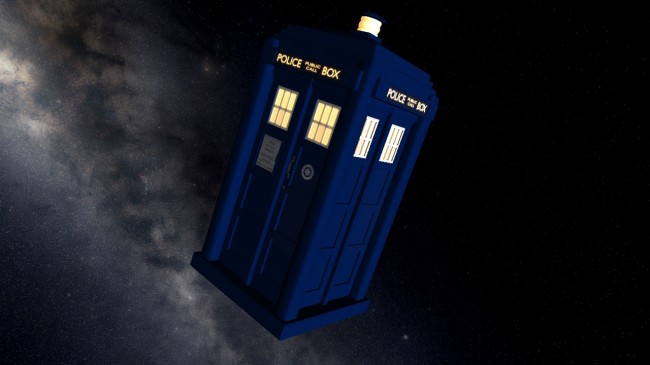
As everyone knows, there’s nothing like a police box for traveling through space… or time.
You can add the police box to any simulation: Add > Objects tab > Police Box.
4. What’s Coming
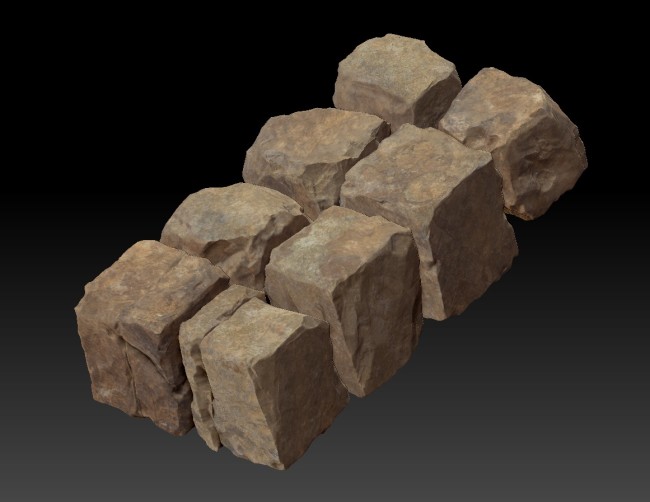
Toby is going to continue making models for Universe Sandbox ², but we’ve decided to take a break from spacecraft for our next model. Wouldn’t it be pretty cool to have a gigantic pyramid floating through space? The image above is a selection of work-in-progress bricks which will lay the groundwork for an Egyptian-style pyramid.
And while you may not have the urge to pilot a pyramid, you’re probably wondering if you’ll ever be able to control the other nice looking spacecraft in Universe Sandbox ². Well… we’re talking about it.
Follow us on Twitter and Facebook for the latest Universe Sandbox ² news.
You can buy Universe Sandbox ² on our website or on the Steam Store.
Universe Sandbox ² Alpha 19 Preview
Apr 30th
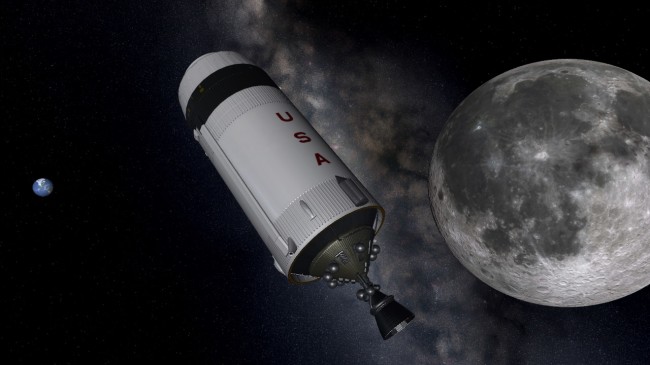
The new model for the third stage of the Saturn V rocket.
We’re still working hard to get Alpha 19 polished and ready to go. We hope to have it ready in the next few weeks.
Until then, you can read about what’s coming in Alpha 19 below and try out a preview version by manually opting in via Steam:
- Right-click on the game title in your Steam Library
- Click on ‘Properties’
- Select the ‘Betas’ tab
- Set the dropdown menu to ‘alpha19preview‘
- Close the Properties window
- Steam will now update Universe Sandbox ² to the preview version
- Once updated, launch Universe Sandbox ²
1. Roche Limit & Tidal Heating
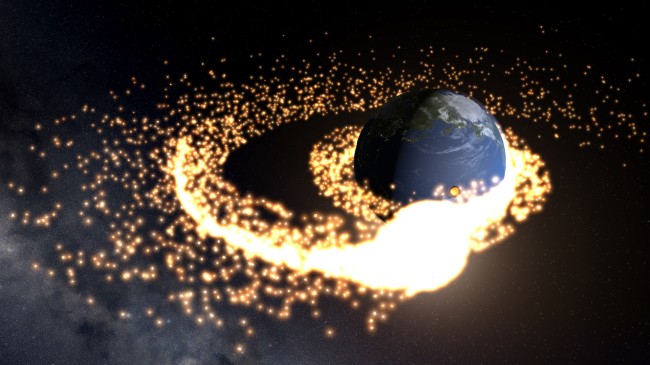
In this simulation, the Moon is orbiting Earth within the Roche limit and is being torn apart by tidal forces.
When a small celestial body approaches a larger body at a distance inside its Roche limit, it begins to stretch and disintegrate due to tidal forces. Essentially, the gravitational force acting on the closer side of the smaller body is stronger than the force acting on the far side. Outside of the Roche limit, these tidal forces are still present and can heat bodies in close orbits.
In Universe Sandbox ² Alpha 19, you can see these effects when a satellite tightly orbits its primary body, or when a star gets too close to a massive black hole, or even if two identically-sized bodies are in a close binary orbit. First, the secondary body will heat up, then if it’s close enough, it will begin to disintegrate and lose mass by producing a stream of particles. Often times these particles will begin orbiting and form a nice glowing ring around the primary body.
2. Models for Saturn V 3rd Stage, New Horizons probe, & Police Box
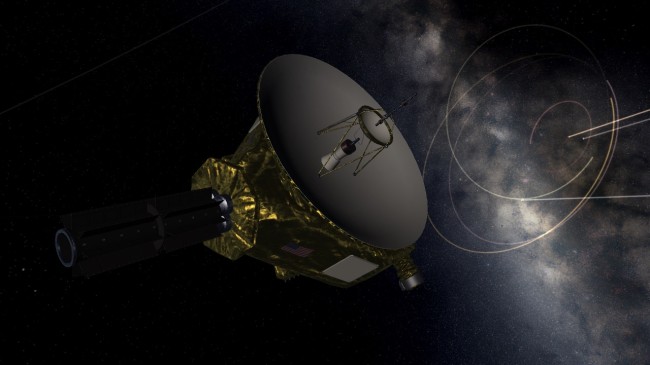
We’ve put in improved models for the third stage of the Saturn V rocket, which was used in multiple lunar missions, and the New Horizons probe, which has famously given us a closer look at Pluto. We’ve also added in another very important spacecraft, the police box. These new and improved models were made for Universe Sandbox ² by Toby Halter, who is continuing to make models for us. It’s not possible to pilot or control these spacecraft… but we’re talking about it.
To check these out, you can load up the following sims:
– Third Stage of the Apollo 12 in Orbit of Earth in 2003
– New Horizons Pluto Encounter in 2015
Or you can place them in any simulation: Add > Objects tab.
3. Improved Explosion Power
We’ve improved both the visuals and the simulated effects for the explosion power.
As you can see in the screenshot above, using Explode on a body will send out a “shock wave” which will affect surrounding bodies as well, causing a chain of destruction. Realistic destruction, of course.
4. Simulation Quality Setting
You can now adjust a Simulation Quality setting in Home>Settings>General tab. This will adjust the maximum number of attracting and non-attracting bodies, which in turn will affect the number of particles/fragments produced and how long they last. Set it to “Auto” to determine the best settings for your hardware.
In the future we hope to have this setting adjust dynamically with what is happening in the simulation, in order to constantly find the best balance between performance and simulation experience.
We still have some bugs to sort through and some polish to add, so hold tight. We’ll let everyone know once Alpha 19 is available.
The laser, which is already part of the VR mode, is still being integrated with the additional surface detail feature. We expect these features to be ready for Alpha 20.
You can buy Universe Sandbox ² on our website or on the Steam Store.
Follow us on Twitter and Facebook for the latest Universe Sandbox ² news.
Celebrating Our Rare and Special Planet on Earth Day
Apr 22nd
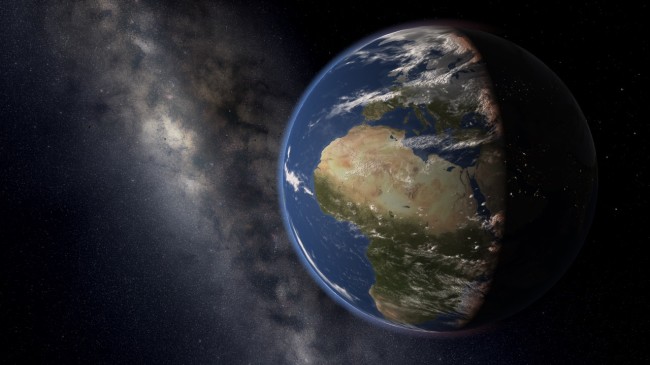
I hear a lot of people say that looking at our universe from a solar system, galactic, or cosmological scale makes them feel small and insignificant. Insignificant to who and what? I look at our universe and I see the incredible complexity that has arisen from a few forces and a few fundamental laws. You see it in the structure of the cosmic background, you see it in the shapes of galaxies, you see it in the heavy elements formed in our stars. Nowhere do you see that complexity more than when you look at life. It was a glorious accident that allowed us to exist, and we exist in an incredibly delicate balance.
99.99999999…% of the universe is empty space. 99.9999999…% of that which is not empty space is lifeless. Why does it matter if somewhere light years away something doesn’t care about your individual existence? We have this amazing planet and it might not be unique in the universe in its complexity, but it is incredibly rare and special, and I feel very significant — overwhelmed with a sense of purpose and duty, in fact — because it is up to us to try as hard as we can to preserve this rare and special place and all the life on it.
The structure of the universe doesn’t make me feel insignificant. It makes me feel incredibly lucky. By some chance I exist in this rare place. Thus it is my duty to try to keep life existing here, and to try to make that life as pleasant as possible for the other rare and lucky creatures who share it with me.
– Jenn Seiler, astrophysicist and Universe Sandbox ² developer.
Learn how we simulate Earth’s climate and how you can explore it in Universe Sandbox ²:
Hiring a Simulation Developer
Apr 21st
This position has been filled. Thank you to everyone who applied.
If this still sounds like an ideal job for you, please reach out. We are always looking for more help from the right candidates.
Giant Army is looking for a simulation developer to help in our continued development on Universe Sandbox ², a space and gravity simulator with a 94% positive rating on Steam.
You will work with scientists and developers to improve and create geophysical and astrophysical simulation code. This code must smoothly integrate with the other systems in Universe Sandbox ², including running in real-time under computational restraints.
Above all you must be an experienced C# programmer (ideally with Unity experience). You do not need to be a subject-matter expert, but you must be a collaborative worker who is curious about science, and you must have a broad toolkit of numerical techniques.
We hope you join us in making something incredible that’s never been done before.
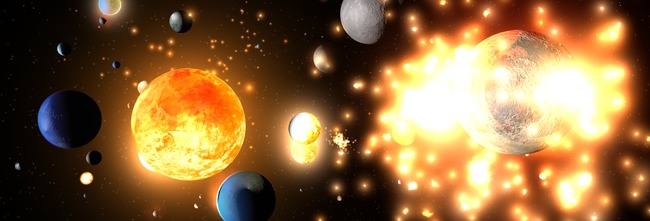
Your Role
- Build on, improve and optimize, and create new geophysical and astrophysical simulation codes which talk to all the other pieces of the simulation
- Work with scientists to define a problem and iteratively determine the best numerical solution that meets computational constraints
- Work with developers to integrate with other systems and the graphical display smoothly
- Quickly prototype and estimate computational costs
- Help change the way the world perceives our universe and fragile planet
Ideal Candidate
- Is a self-driven and talented programmer with experience applying/integrating numerical models in a compiled language using modern developer best-practices
- Writes clean code that is comprehensible to teammates
- Loves physics simulations and fantastical what-if scenarios: what-if.xkcd.com (note citation #6 on 148)
- Is excited about developing a tool that allows users to experiment with simulations, pushing the boundaries of what has been done in real time for public consumption
Mandatory Qualifications
- (Strong C# && Unity Engine experience) || (Experience with an entity component model && object-oriented programming)
- Experience with developing simulations
- Familiar with version control, some kind of task-management system, unit tests, code reviews, and so forth
- Familiar with a broad toolkit of numerical techniques
- Works collaboratively
- Curious about science
- Enjoys a challenging problem
Preferred Qualifications
- M.S. in relevant field (e.g. applied math, computer science)
- Ability to meet in person at least once a week in Seattle, WA, United States, but will consider outstanding candidates from anywhere in the world
Partial List of Simulation Improvements
- Improving the climate simulation (calculating temperature, pressure, greenhouse effect, user adjustable materials, dust from impacts affecting the temperature)
- Improving asteroid collisions (heating, impact size, velocities of fragments)
- Adding atmospheric drag (based on the properties of the body and the atmosphere, with correct heating of the body and material loss from the friction and heat)
- Improving our material system (metallic hydrogen in gas giants, simulating subsurface oceans on moons)
- Improving supernova and stellar evolution (and making that all work smoothly together)
- Improved transitions of bodies as their properties change (add hydrogen to a rocky body to make it become a gas giant, keep adding to turn it into a star)
- This position is (largely) not oriented toward improving the following:
- N-body
- Relativity
- Fluid dynamics
More Information
You don’t need to be a subject-matter expert in any area of geophysical sciences or astronomy, but you must be curious about science, and love the idea of working with scientists who would lay out a computational problem that you could help solve and implement. Everything must run in real time; computational efficiency is key. Sometimes the level of complexity that we can represent is a continual negotiation depending on the efficiencies that prove possible. Which is why this work is incredibly important for making Universe Sandbox more awesome.
There is an element of iteration with the scientists and developers. We may start from a wish-list or pseudocode that is too computationally expensive, and iterate from there, coming up with new ideas for which simple models of the physical process to suggest next. Your job in this iteration is to quickly prototype, if needed, and provide estimates for whether the current idea has yet achieved feasibility.
Besides the scientists who want to compute things in real time, the graphics programmer is concerned with displaying them smoothly, so you also need to iterate on the output and its interface with the graphical display. And because it’s a sandbox on a broad scale, everything must integrate well with existing systems. Models of specific processes do not exist in isolation of the influence of the rest of the simulation; everything must work together and be designed with this in mind.
This is very much a collaborative position, and so the ability to work well in a team is an important qualification. You must be good at working with other people’s code, and you need to be able to take direction from the creator of Universe Sandbox on design constraints, from the scientists on physical realism, and work with the systems architect to make it all operate smoothly with the core simulation and gravity integration that is already in place. You may work with the numerical physics programmer responsible for the gravity integration on problems like threading and other computational optimizations for the software at large.
Portfolio-wise, visualizations are appreciated. Visualizations of simulations that did not run in real time may impress us, but in this position everything must run in real time, so things that do will impress us more, perhaps in the form of runnable code (e.g. an executable).
Company Overview
Giant Army is the company behind Universe Sandbox, a space simulator that’s sold hundreds of thousands of copies on Steam. Our headquarters are in Seattle, Washington, USA, with team members in Arizona, Missouri, Germany, and Denmark.
Team members enjoy a flexible, collaborative environment. We pursue the features that get us excited about science. We do the work so that we can share that with others. We’re also committed to creating an accessible experience that can’t be found elsewhere.
Science is for everyone, and we welcome all qualified applicants.
Product Overview
Universe Sandbox ² is our core product that lets the user explore and learn about our amazing universe and fragile planet while creating and destroying on a scale they’ve never before imagined. It’s more than a game; it’s a way of experiencing and learning about reality in a way that’s never been done before. Early alpha access now available for Windows, Mac, and Linux.
How to Apply
This position has been filled. Thank you to everyone who applied.
If this still sounds like an ideal job for you, please reach out. We are always looking for more help from the right candidates.
Email us: jobs at universesandbox.com
In the email please include:
- Relevant email subject
- Link to or copy of your resume or CV
- Relevant code sample/s
- Link to examples of your work, including visualizations of numerical simulations
- Answers to these two questions:
- What is the most appealing part of this opportunity?
- What feature would you be most interested in adding or helping make better?
- Where you originally heard about this job posting
Hiring a Producer
Apr 6th
This position has been filled. Thank you to everyone who applied.
If this still sounds like an ideal job for you, please reach out. We are always looking for more help from the right candidates.
Giant Army is looking for a producer to help in our continued development on Universe Sandbox ², a space and gravity simulator with a 94% positive rating on Steam.
You will work closely with the project lead with the overall goal of making Universe Sandbox ² even more realistic, accessible, and awesome. You will also work with the team as a whole to organize and prioritize tasks and projects, while helping ensure goals are met within established time-frames. You must be self-directed, organized, and an excellent communicator.
We hope you join us in making something incredible that’s never been done before.
Your Role
- Work with the team to help change the way people think about our amazing universe and fragile planet
- Work closely with Dan, the project director, to discuss, articulate, and execute on the project goals
- Maintain a broad view of the project to ensure it is oriented toward these long-term goals each step of the way
- Work with each team member to maintain a clear vision of their individual progress and stay on track towards goals in established time-frames
- Maintain, prioritize, and coordinate plans for projects which involve multiple team members
- Help make decisions and provide possible solutions to problems
Ideal Candidate
- Interested by physics simulations and fantastical what-if scenarios: what-if.xkcd.com (note citation #6 on 148)
- Experience with software/video game/educational development, having worked with both artists and programmers
- Has educational, business, and/or marketing acumen
- Has experience as a lead or in some role managing others
- Has ideas for improving production and an understanding of agile methodologies
- Ability to meet in person at least once a week in Seattle, WA, United States (or willing to relocate), but we will consider outstanding candidates from anywhere in the world (without relocation)
Mandatory Qualifications
- Excited about science & improving the user experience
- Self-directed, comes up with good ideas and executes them
- Enthusiasm for the project’s science-focused vision
- Energized by meetings, personal interactions, and problem solving
- Personable and energized by working with a wide-variety of personalities
Company Overview
Giant Army is the company behind Universe Sandbox, a space simulator that’s sold hundreds of thousands of copies on Steam. Our headquarters are in Seattle, Washington, USA, with team members in Arizona, Missouri, Germany, and Denmark.
Team members enjoy a flexible, collaborative environment. We pursue the features that get us excited about science. We do the work so that we can share that with others. We’re also committed to creating an accessible experience that can’t be found elsewhere.
Science is for everyone, and we welcome all qualified applicants.
Product Overview
Universe Sandbox ² is our core product that lets the user explore and learn about our amazing universe and fragile planet while creating and destroying on a scale they’ve never before imagined. It’s more than a game; it’s a way of experiencing and learning about reality in a way that’s never been done before. Early alpha access now available for Windows, Mac, and Linux.
How to Apply
This position has been filled. Thank you to everyone who applied.
If this still sounds like an ideal job for you, please reach out. We are always looking for more help from the right candidates.
Email us: jobs at universesandbox.com
In the email please include:
- Relevant email subject
- Link to or copy of your resume or CV
- Answer to the following two questions:
- What is the most appealing part of this opportunity?
- Why would you be a good producer on this project?
- Where you originally heard about this job posting
VR is Now Available for Universe Sandbox ²
Apr 4th

For the past few months our highest priority has been adding in HTC Vive/SteamVR support for Universe Sandbox ². The team’s hard work has paid off: we now have a fully-functional virtual reality version which allows you to walk and fly around your simulations, melt planets with a giant laser, then grab them and hurl them off into nothingness with a flick of the wrist.
The best way to experience the amazing sense of scale and immersion in Universe Sandbox ² VR is to put on a headset and check it out for yourself. But if that’s not possible, then here’s a trailer for Universe Sandbox ² VR, featuring user-created VR gameplay videos courtesy of Brad Lynch and Count Lorek of BMcD Gaming.
VR is Free for Owners of Universe Sandbox ²
Universe Sandbox ² now includes both the desktop version and the new VR mode. So anyone who buys Universe Sandbox ² will also receive Universe Sandbox ² VR, and anyone who already owns Universe Sandbox ² can access the VR mode at no extra charge.
If you own Universe Sandbox ² on Steam and have access to a Vive, just run Steam to update. Then launch Universe Sandbox ² and select “Launch Universe Sandbox ² in Steam VR Mode” in the popup dialog box.

Lots of Love for Universe Sandbox ² VR at GDC
Thanks to Valve, we were able to demo our VR version of Universe Sandbox ² in the Steam booth two weeks ago at GDC, the world’s largest professionals-only video game conference.
We received great feedback from everyone who stopped by for a demo, with many agreeing that it was one of the most compelling VR experiences they had tried.
PC Gamer assistant editor Tom Marks said Universe Sandbox ² “was one of the coolest thing [he’s] tried on Vive so far.” Check out the video below for his discussion of Universe Sandbox ² VR:
Scott Manley, a popular YouTuber whose videos combine science and games, was one of the first to stop by for a demo:
Casually throwing Mars through Saturn's rings in @UniverseSandbox pic.twitter.com/6GX3ZYTd0H
— Scott Manley (@DJSnM) March 17, 2016
Here’s a small write-up from Rock Paper Shotgun editor Graham Smith: Universe Sandbox ² Now Has a Virtual Reality Mode
In another article about VR, Graham mentions Universe Sandbox ² as one of the few upcoming VR games which he thinks “look spectacular.”
And here’s an older article from UploadVR, based on an interview with Dan, creator and project lead on Universe Sandbox ²: Literally Play Pool with the Planets in Universe Sandbox ² VR

What’s Next for VR?
We still have work to do, but we’ve already got an enjoyable and impressive VR experience. Beyond adding polish to the interface, we also have to work on getting the best performance possible in order to keep up with VR requirements of 90 frames per second. With VR it’s crucial to meet this requirement in order to keep the risk of motion sickness at a minimum.
We’ll continue to work on the VR version as well as the desktop version, and we’ll release updates when they’re ready. We don’t support Oculus Rift yet, but we’re looking into adding this in once the Touch is available.
You can buy Universe Sandbox ² on our website or on the Steam Store.
Did We Say VR? We Meant RV! Cruise Around Space with RV Mode
Apr 1st
RV photo credit: Greg Gjerdingen (CC License)
RV Mode is Coming Soon to Universe Sandbox ² (sorry, it’s RV, not VR mode)
First, we must apologize for this typo which was made many, many times in many of the posts here and on our promotional material. While we’re not sure who was responsible for editing these posts, we’re in the process of hiring someone now who can find the culprit and immediately fire them. We will then immediately fire this new employee as well.
So to be clear, we meant to say RV mode, not VR mode. We’re talking recreational vehicles here, not virtual reality. Yep, RVs, those huge clunky things you can use to take the whole family on the greatest ever cross-country road trip, with no need for rest stops because inside of that RV you’ve got a bathroom, plenty of room to pace back and forth, and, if you’re lucky, even a satellite TV.
Step Inside the RV of Your Dreams… In Space
While a VR mode for Universe Sandbox ² does sound pretty cool (we’ll look into this), the RV mode which we’ve actually been focusing on for the past few months is something which we think you’ll agree is way cooler.
Just imagine: You load up a simulation of our solar system and engage RV Mode. Suddenly you’re sitting in the cushy front seat of your very own recreational vehicle, feeling like royalty on the Intergalactic Highway. You kick it into high gear and blaze through space at 60 miles per hour (that’s about 96 km/h if you’re in Europe), looking out the huge, panoramic windshield as you pass the gas giants of our solar system. What’s that, not interested in Jupiter’s moons? No problem, take a break and check out the kitchenette. Explore the mini-fridge. Explore the contents of the pot on the hot-plate. Are you picking up a signal on the satellite TV? If so, explore the 200+ channels of premium content.
Of course, while making this RV Mode we haven’t forgotten about the spirit of the sandbox. So yes you can still experiment and get answers to fantastical what-if questions like, “What if I put the hot tub jets [yes you can unlock a hot tub] on full blast? How much sooner will I run out of gas?” or “What if I open the windows?” or “What if I drive this thing right into the sun?”
Why RV Mode for Universe Sandbox ²?
Good question. But have you considered “Why not?”
Truth be told, this may seem like it’s coming out of left field for a space and gravity simulator, but since day one it’s been part of the dream for Universe Sandbox ². Dan Dixon, creator and project lead on Universe Sandbox ², pointed out the obvious reason: “The driving force behind this project has always been about giving the player the freedom and tools to do whatever they want. And what embodies freedom more than cruising around the universe in an RV?”
So forget about exploring your Universe Sandbox ² simulations in full 3D and waving your hands around to make planets collide. The real frontier of next-generation gaming lies in the powerful and inspiring potential of the RV, the cutting edge of unwieldy, carbon-friendly (and family-friendly) automobiles.
Again, sorry for all those typos.
Exploring Some Lesser-Known Features
Mar 7th
Maybe you’ve noticed that there are a lot of features in Universe Sandbox ². As we continue development, we work on ways to make all of these features discoverable and easy-to-use.
But some remain a little hidden right now. So here’s a list of some of the features we see commonly requested, and which are actually already in Universe Sandbox ².
1. You can fly the camera around your simulation using the WASD keys.
- Use the WASD keys on your keyboard to freely move the camera around
- Click and drag the mouse to point the camera in a different direction
- You can use this to focus the camera on a point in your simulation instead of a specific body
2. Want to see moons and rings in our solar system? The default sim doesn’t have these because they tend to slow things down, but you can load sims which do.
- Search for “moon” or “ring” in Home > Open to find simulations which have the moons and rings of our solar system
- These sims require a lot of accuracy to keep moons and rings in tight orbits, so they tend to run slower than a standard simulation
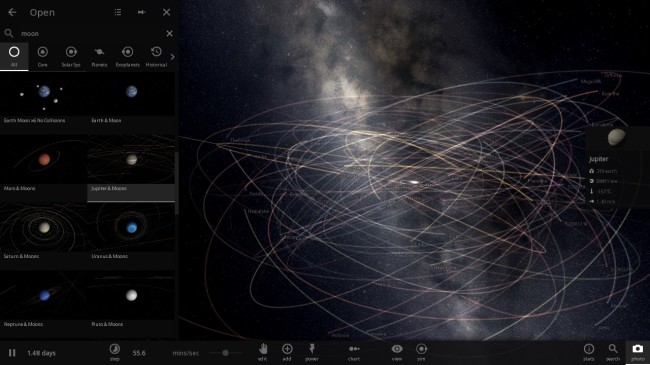
3. Or you can add rings yourself to any body in a simulation.
- Select a Body > Add > Rings tab > Select a preset > Add Ring
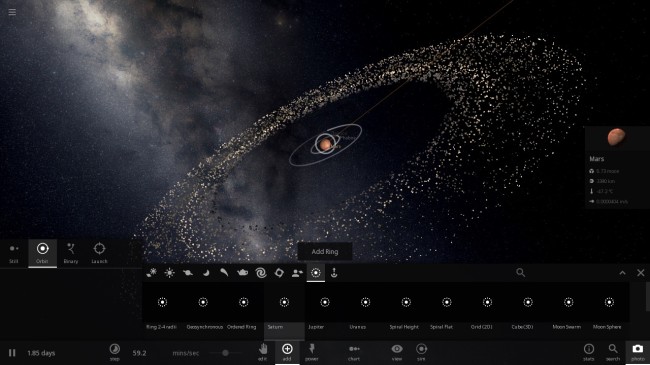
4. Universe Sandbox ² has a database of over 50 thousand known objects.
- Use the search bar in the Add panel to find less common objects
- Add > Search bar (top right)
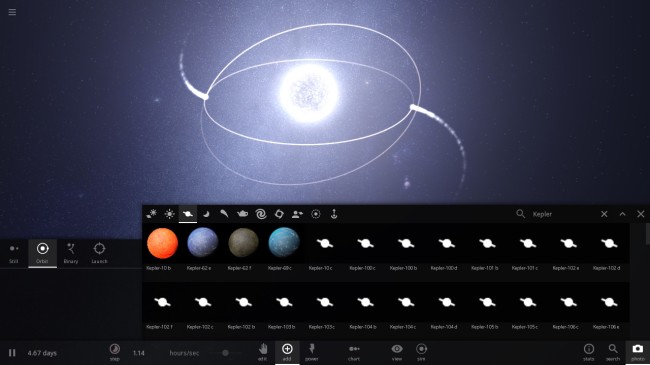
5. You can land the camera on the surface of a body.
- Click twice to focus on a body > Press C on your keyboard
- Press C again to return to the normal camera view
- Getting dizzy? Properties > Motion tab > Rotation Lock (bottom of list)
6. You can create randomly-generated solar systems.
- Home > Create > Systems
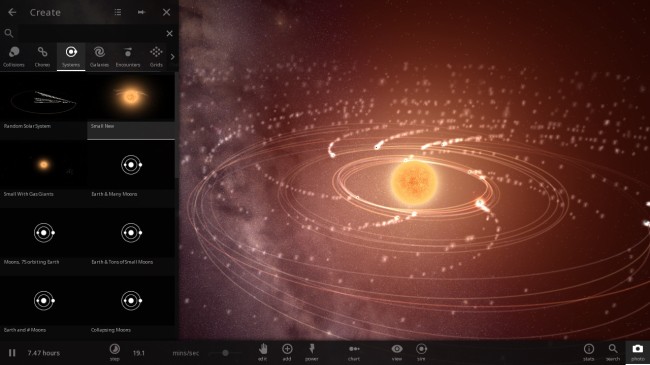
7. Earth and Mars both have climate simulation.
- Select Earth or Mars > Properties > Climate tab > Enable Climate
- Learn more about how we simulate climate in our Climate post
8. Accidentally delete the sun? No worries, you can Undo!
- Press Ctrl+Z on your keyboard to undo your last action
- This is still a work-in-progress feature and does not undo every action
9. You can change the frame of reference for trails.
- Select a body > Properties > Actions tab > Set as Trail Center
- Return to default: Actions tab > Clear Trail Center
- For example, instead of seeing how bodies in our solar system move in relation to the sun, you can see how they move in relation to Earth, as shown in the screenshot below
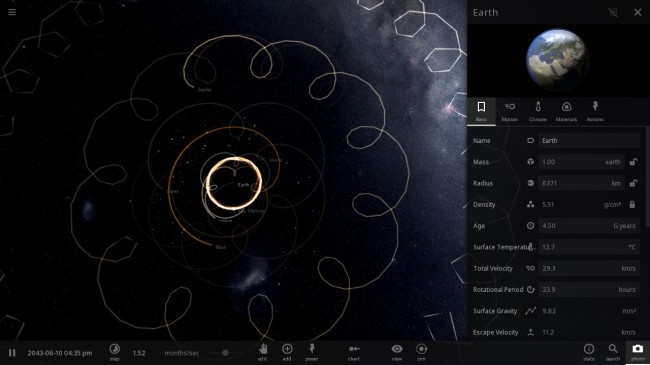
10. You can view and customize keyboard shortcuts for many commands.
- Home > Settings > Input
11. You can hide the interface at any time for a more cinematic view.
- Press Tab on your keyboard to hide the interface
- Press Tab again to make it return
12. You can change a simulation’s starting date, have it start paused, and adjust other advanced starting parameters.
- Home > [Open or Create] > Hover over a preset and click the pencil icon
13. Bodies and trails can be colored according to their velocity, mass, or acceleration.
- View > Colors

